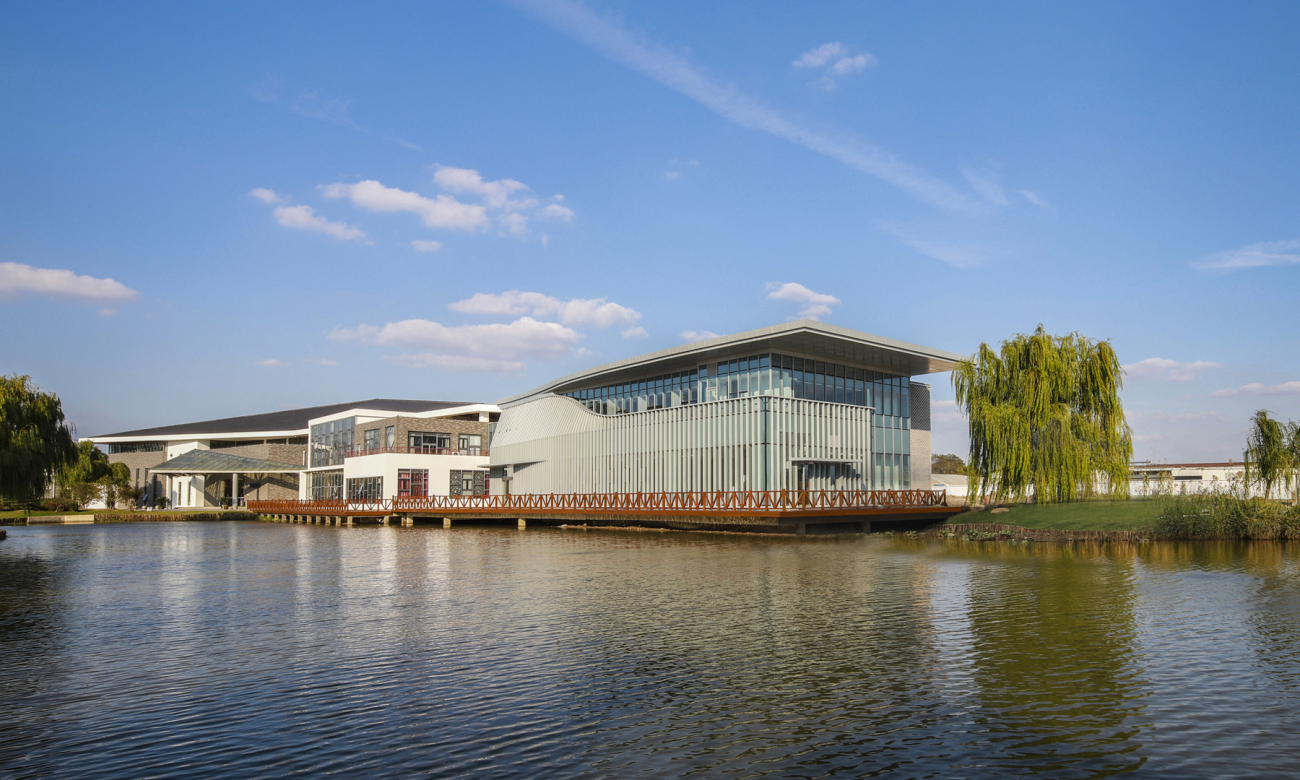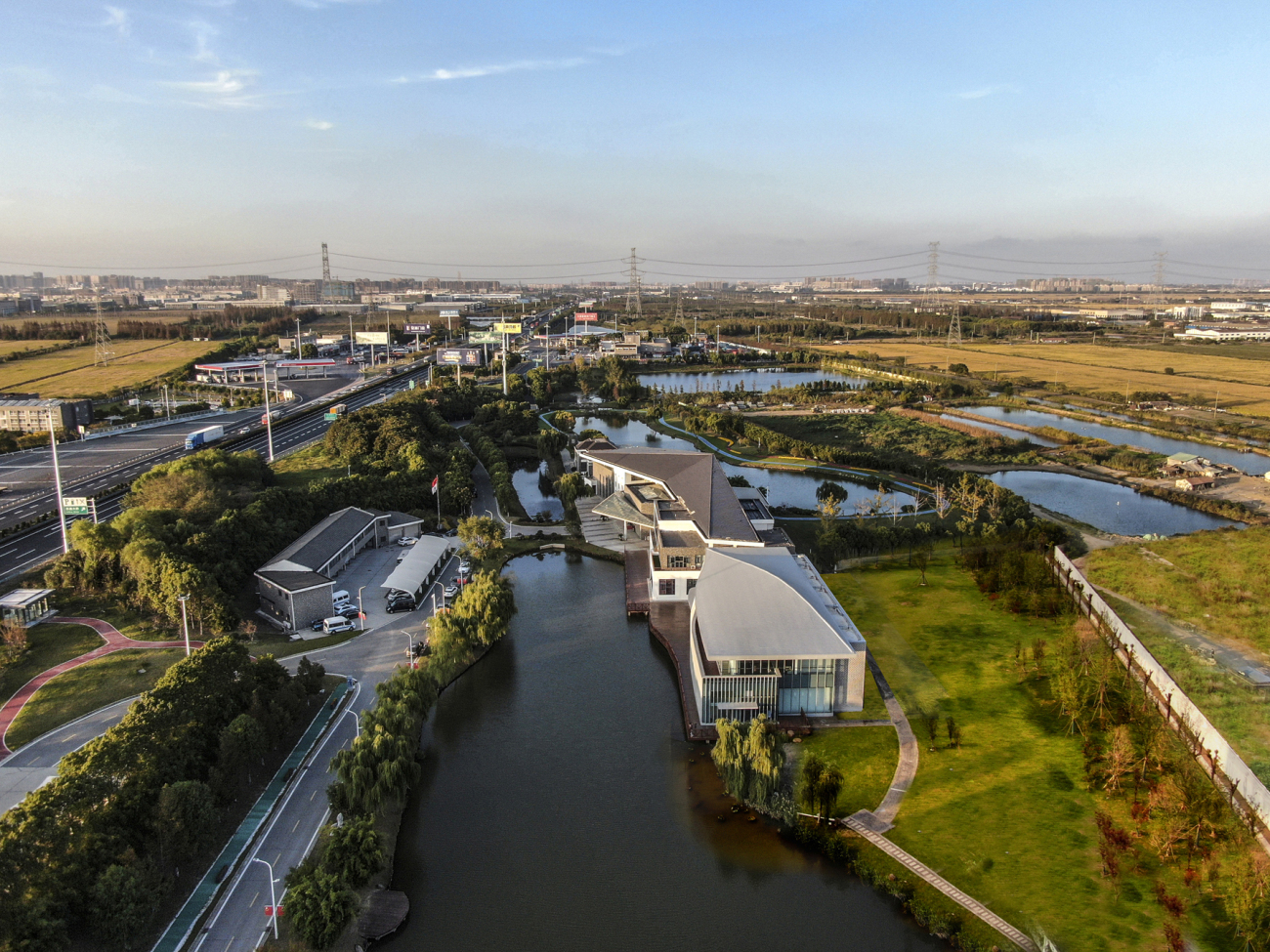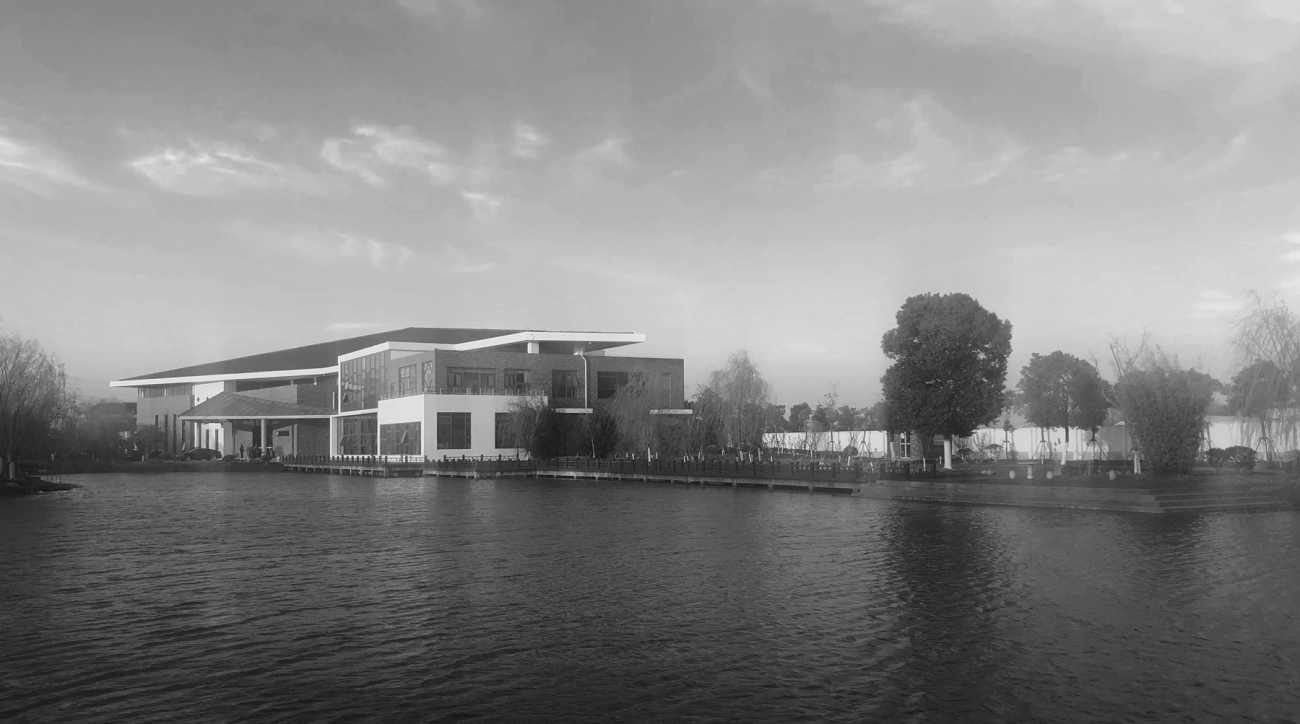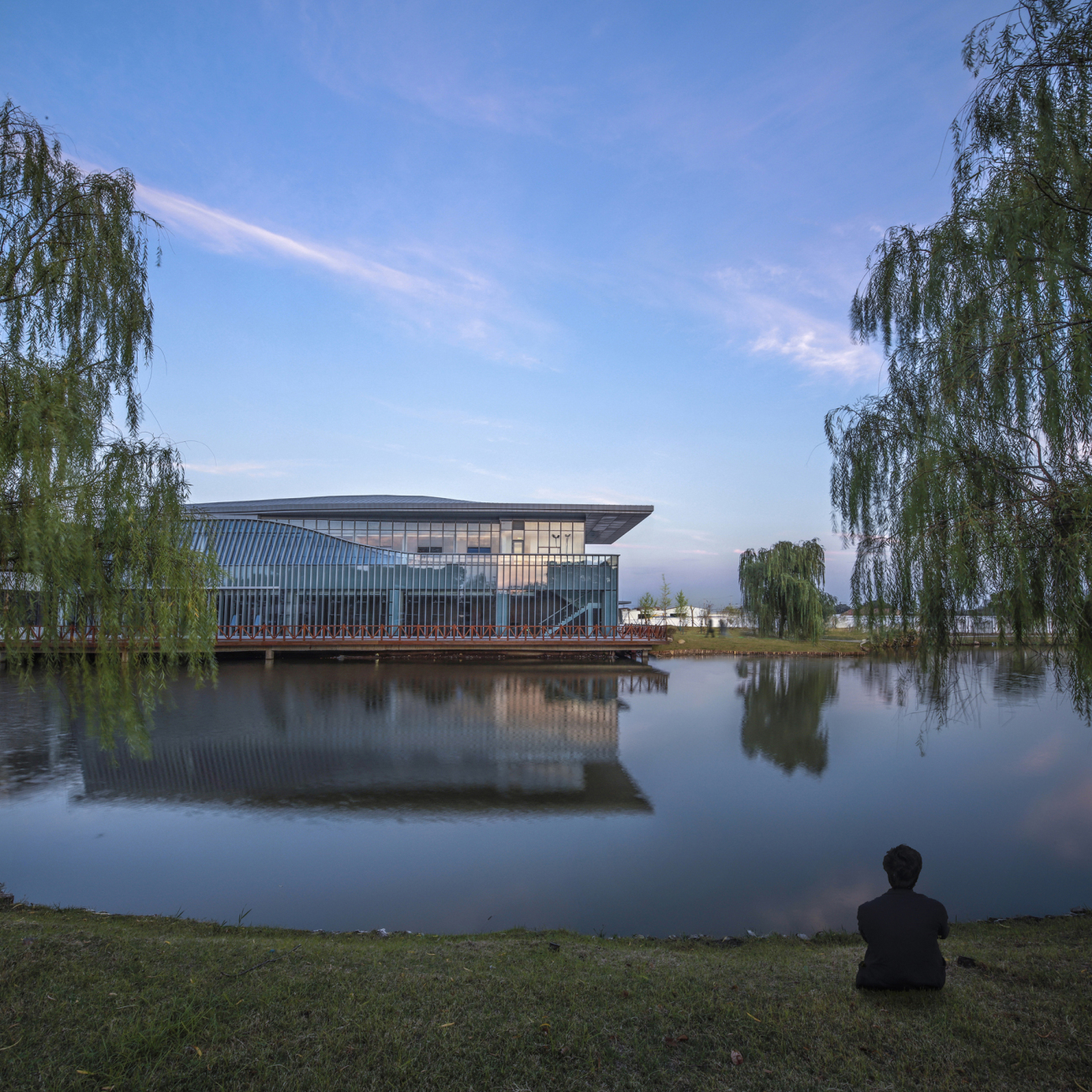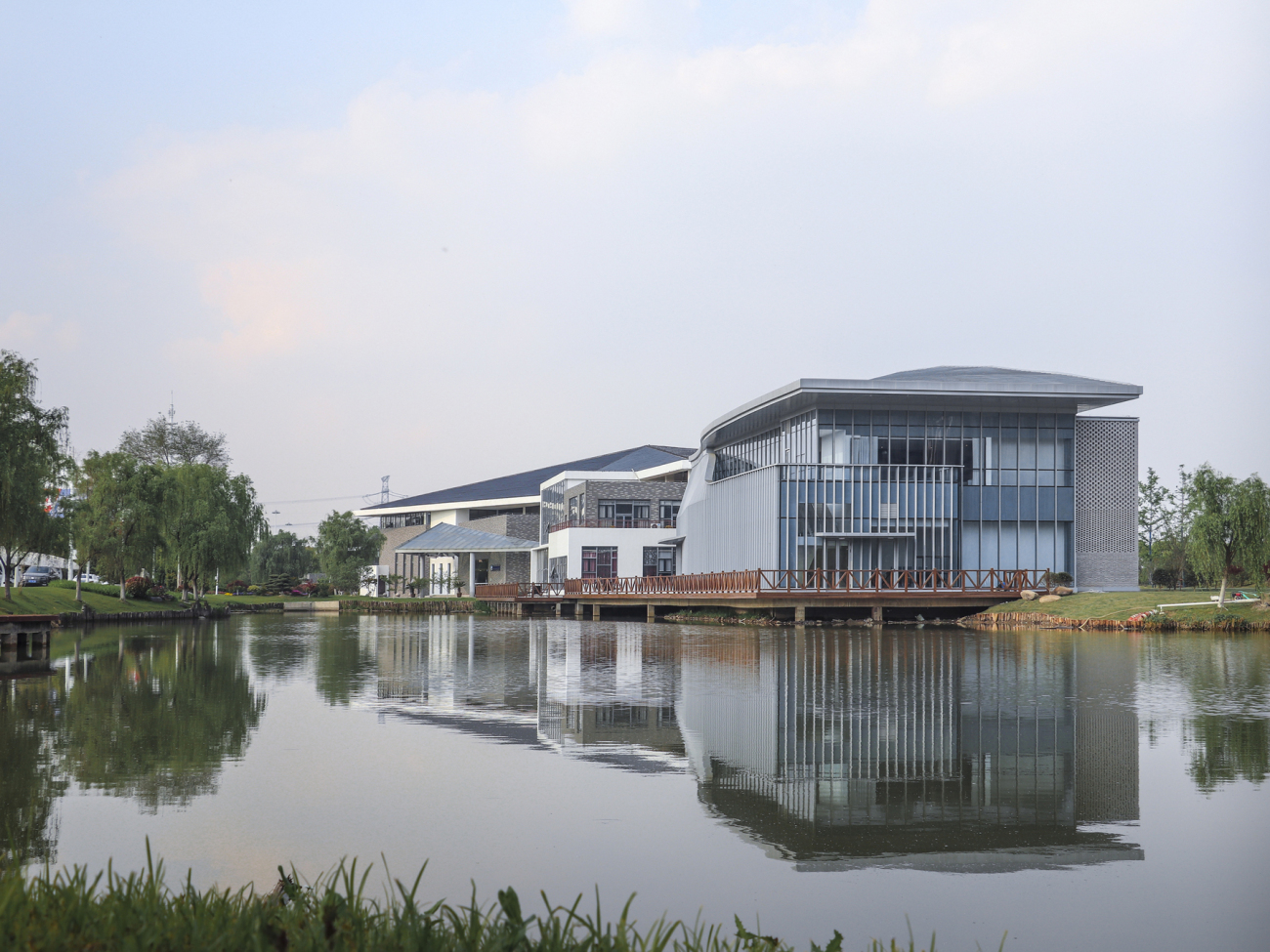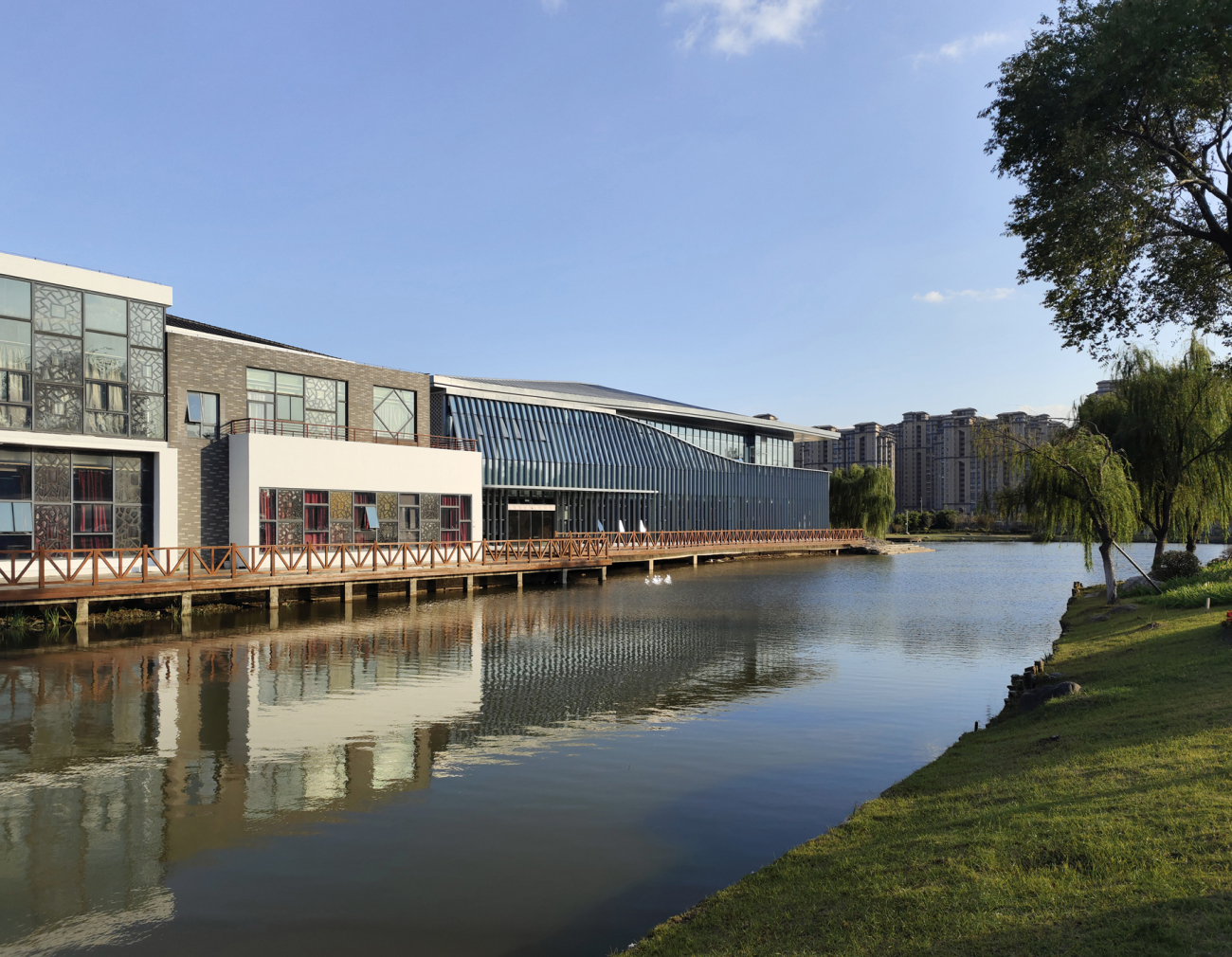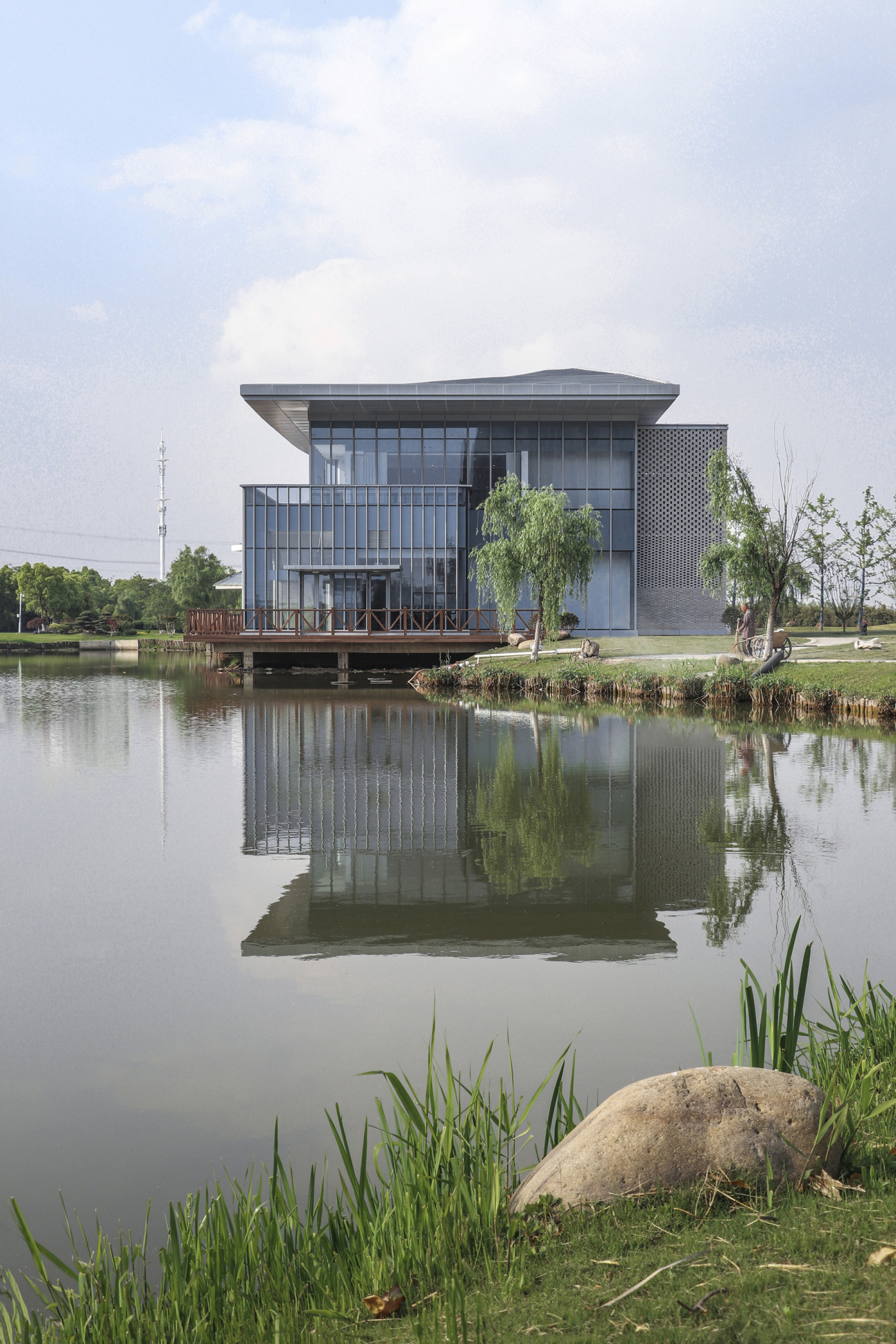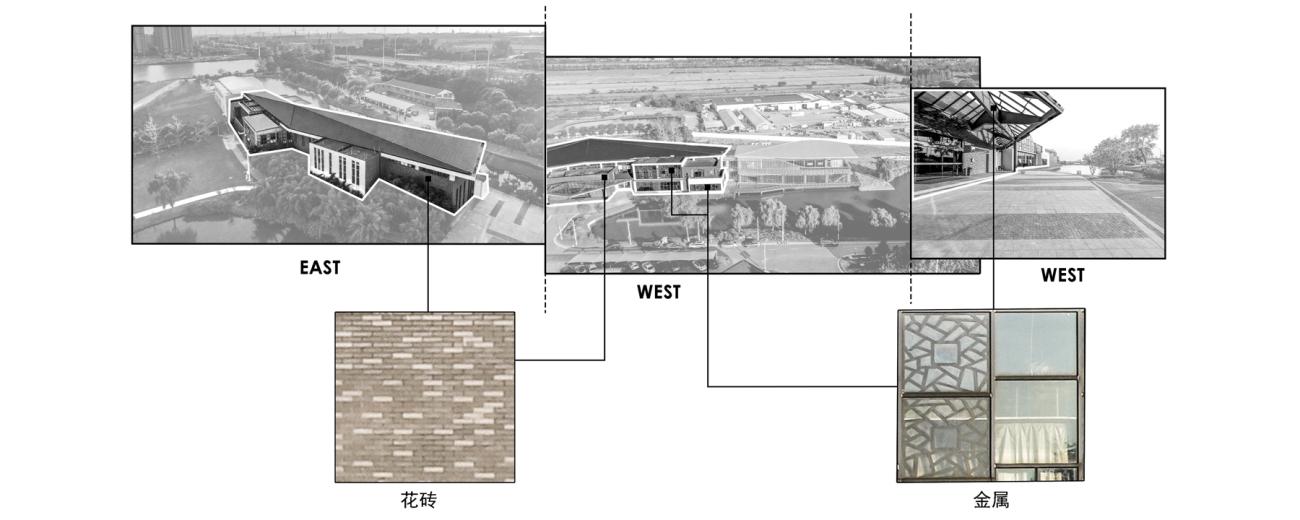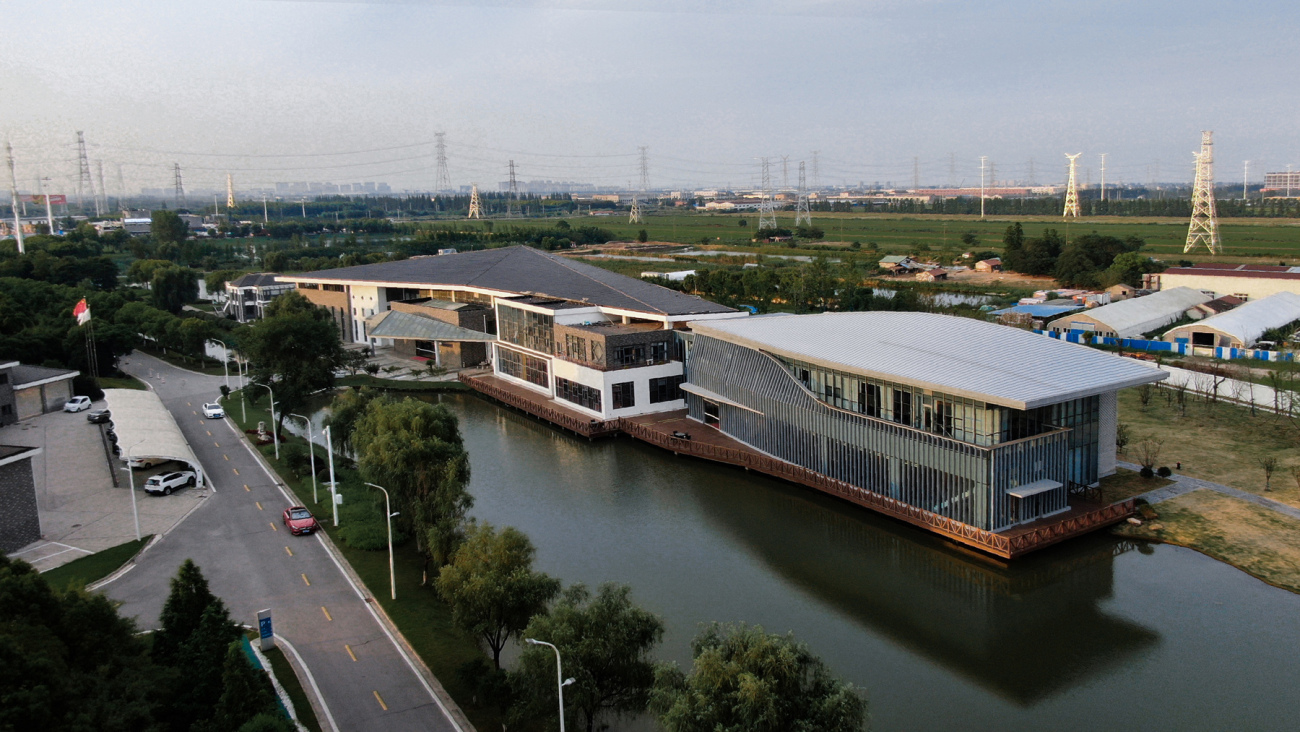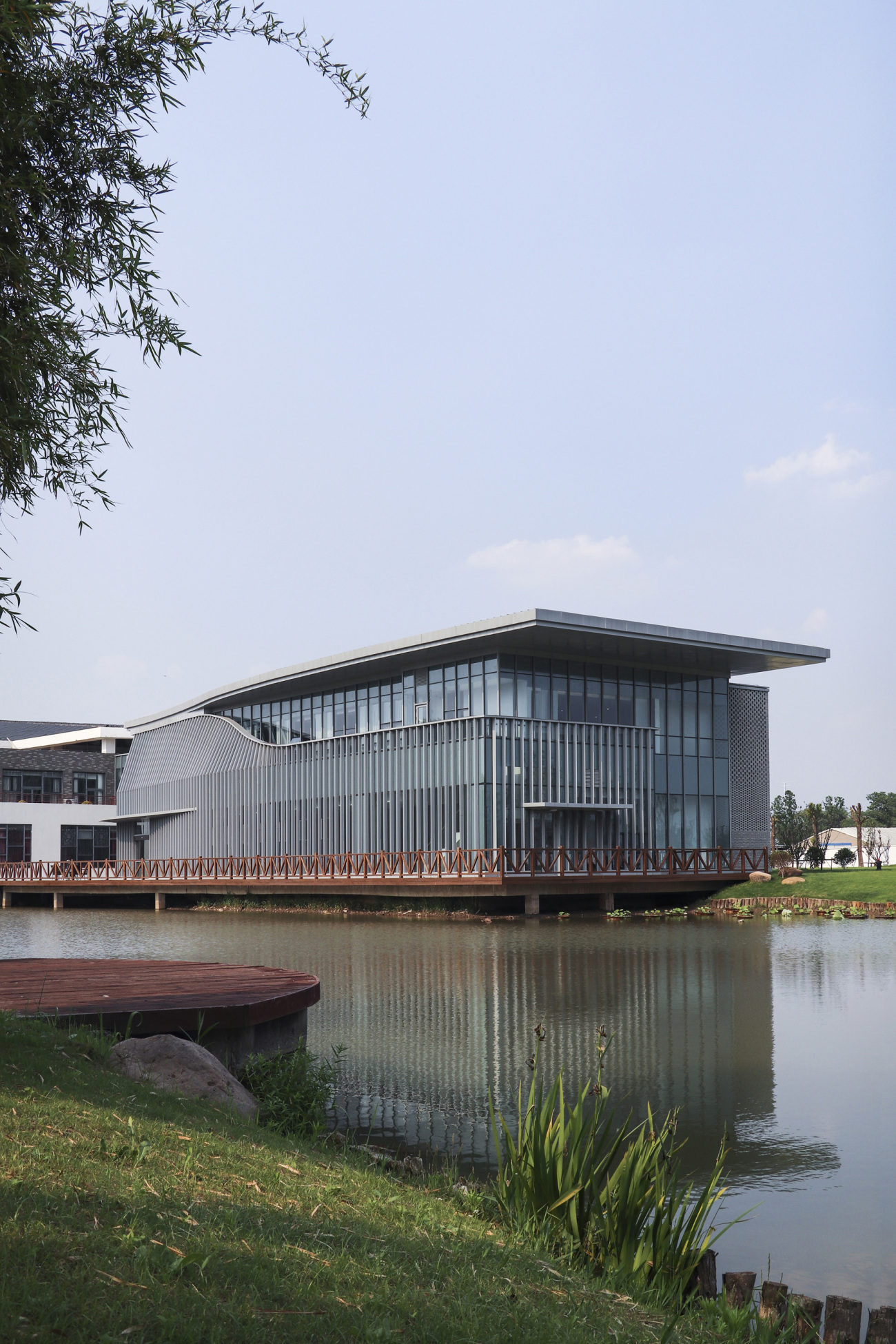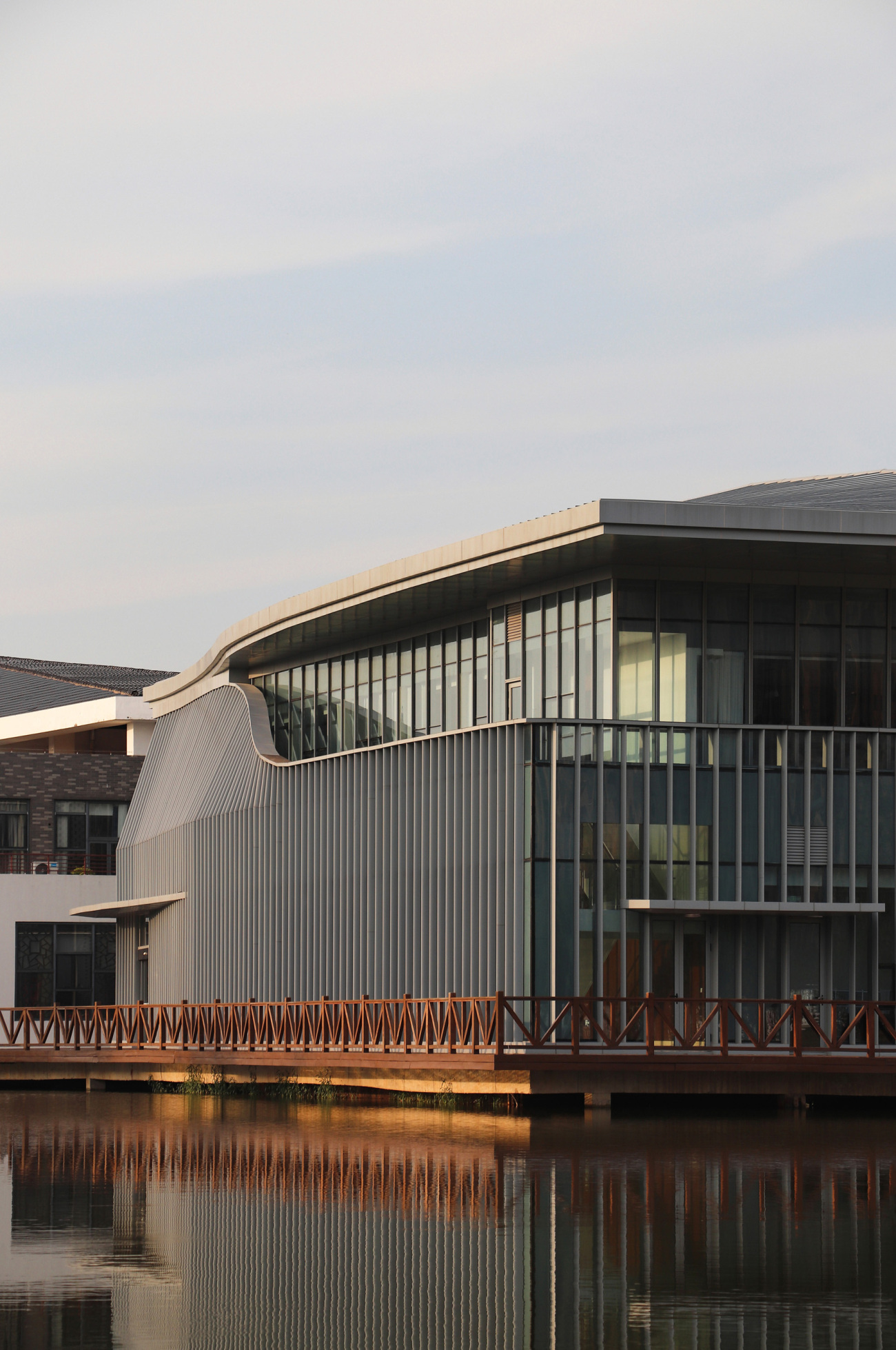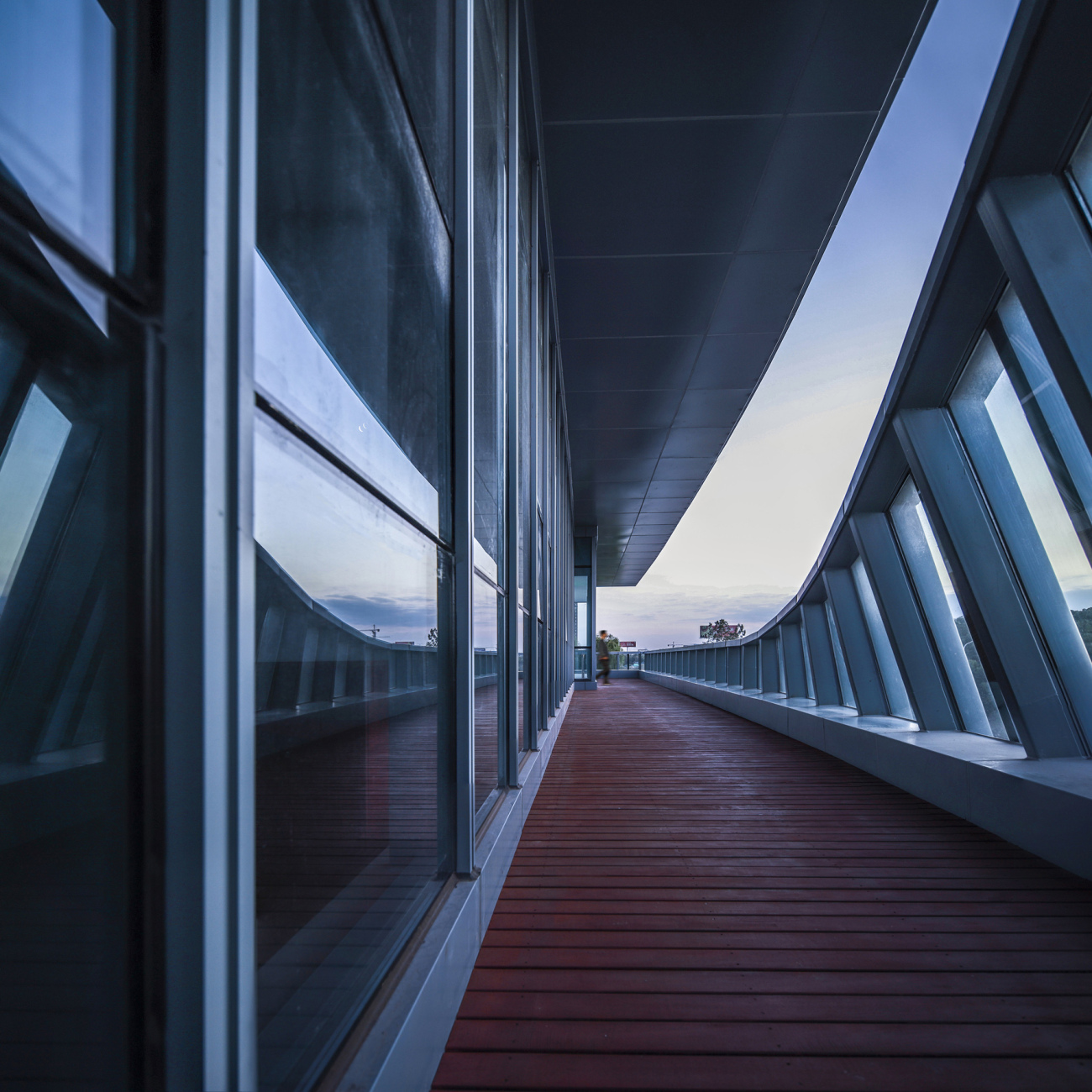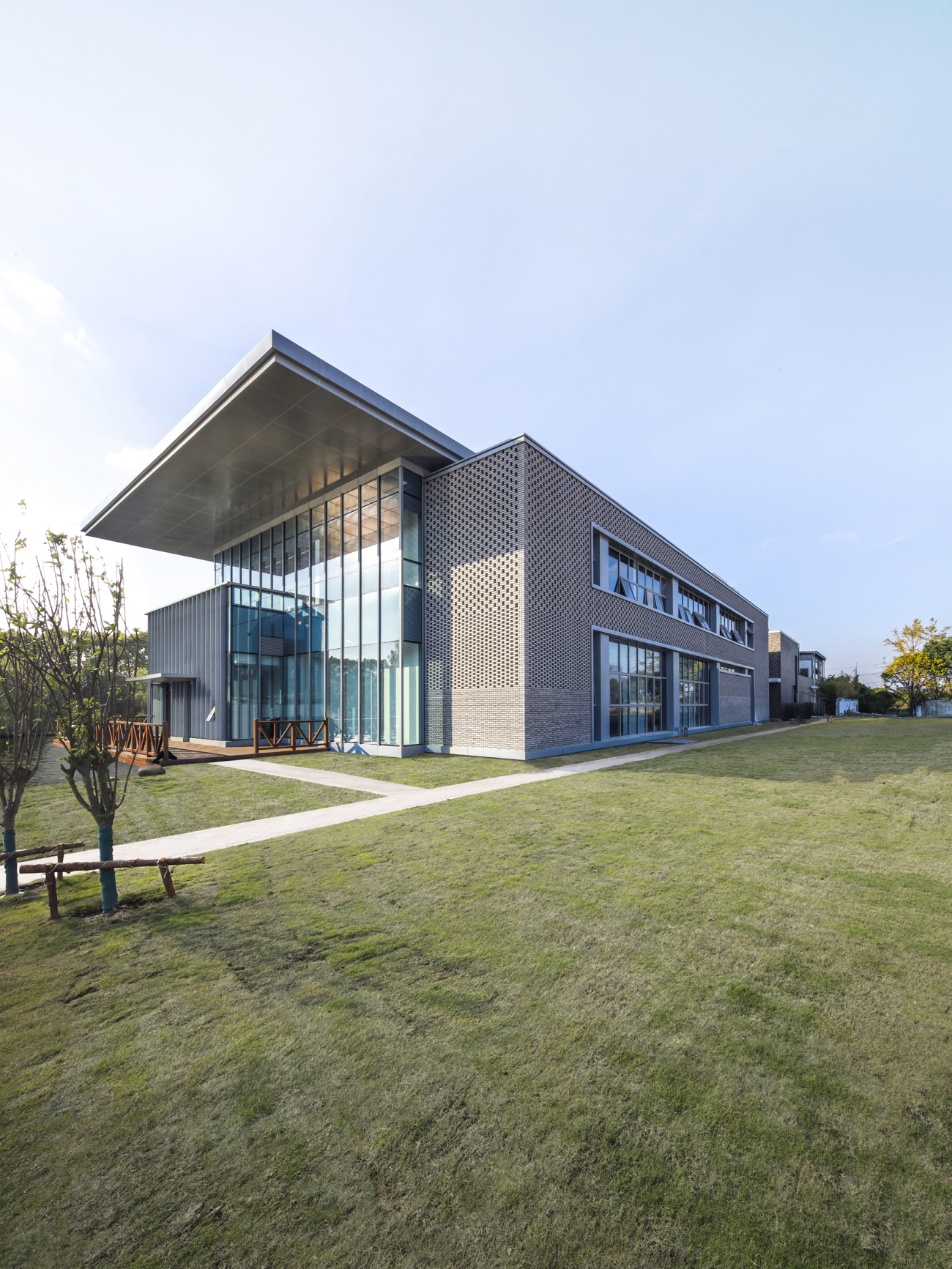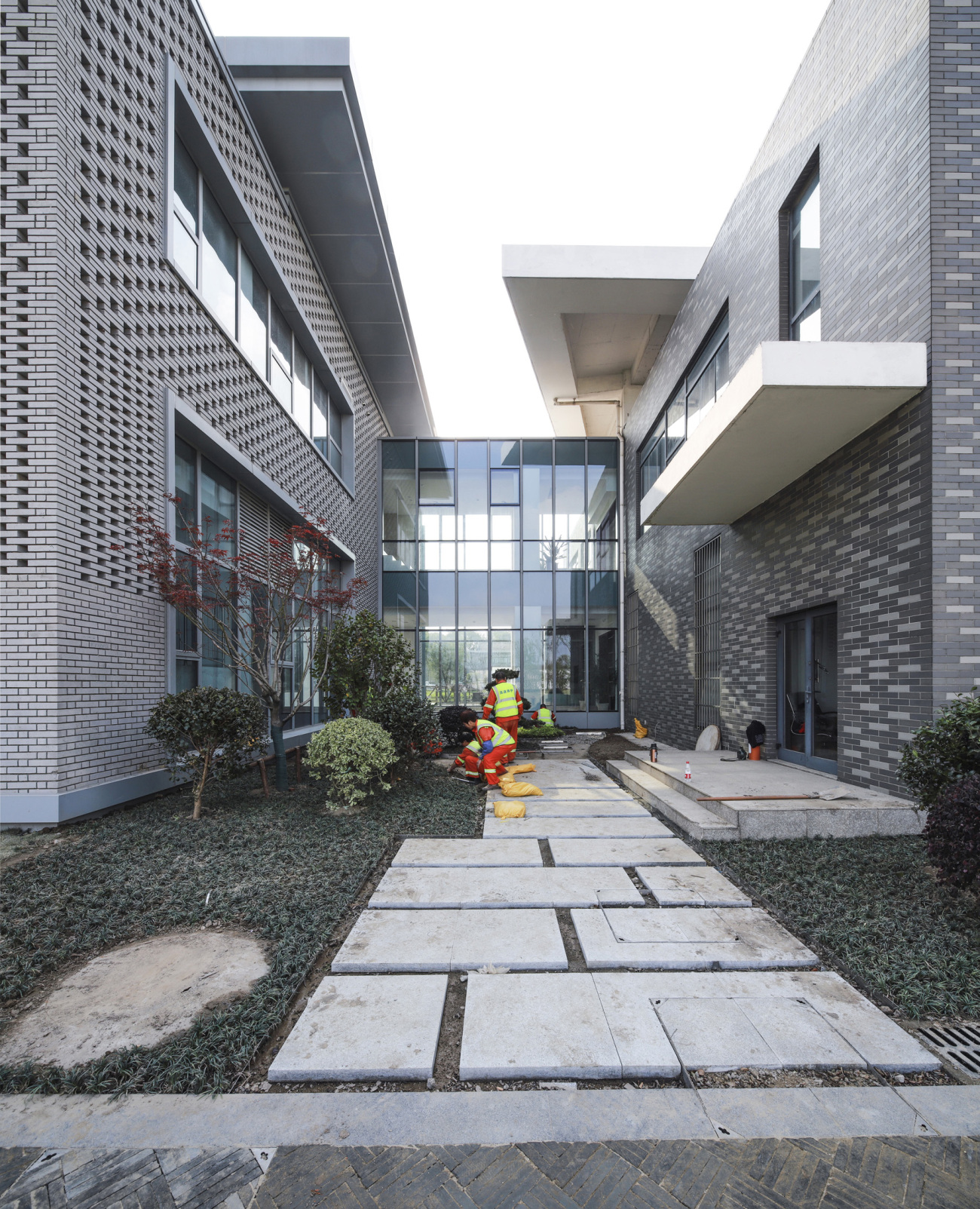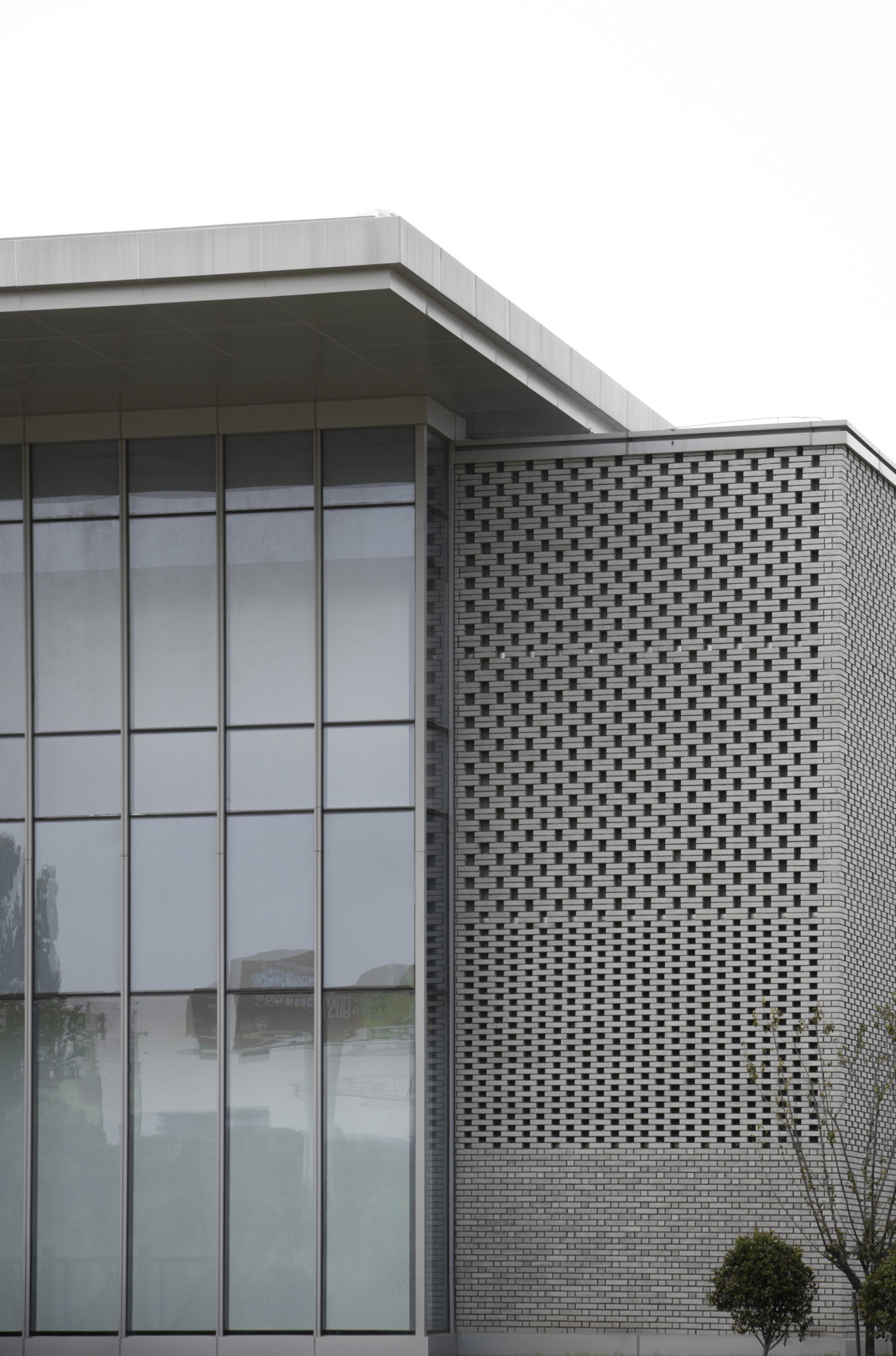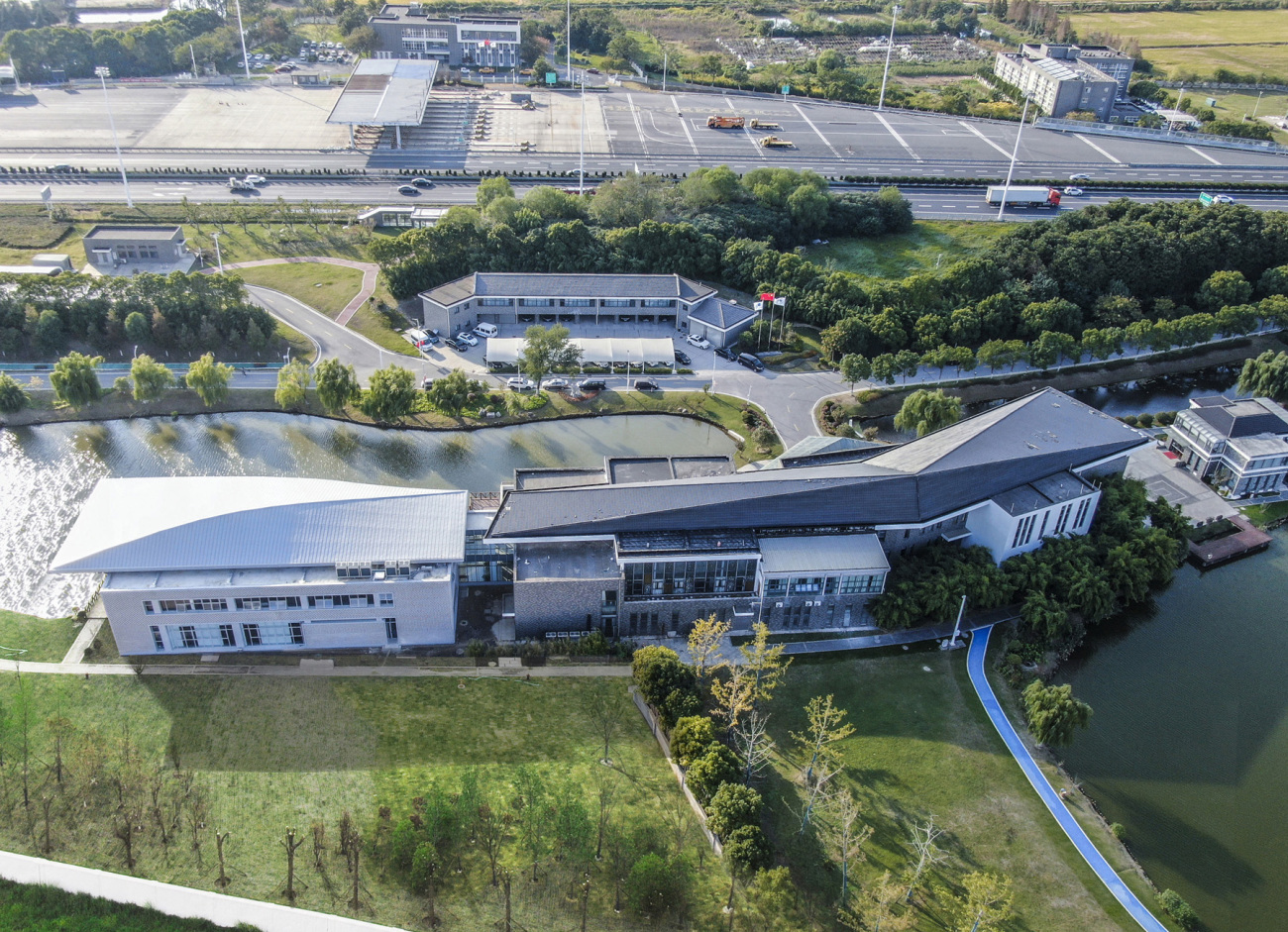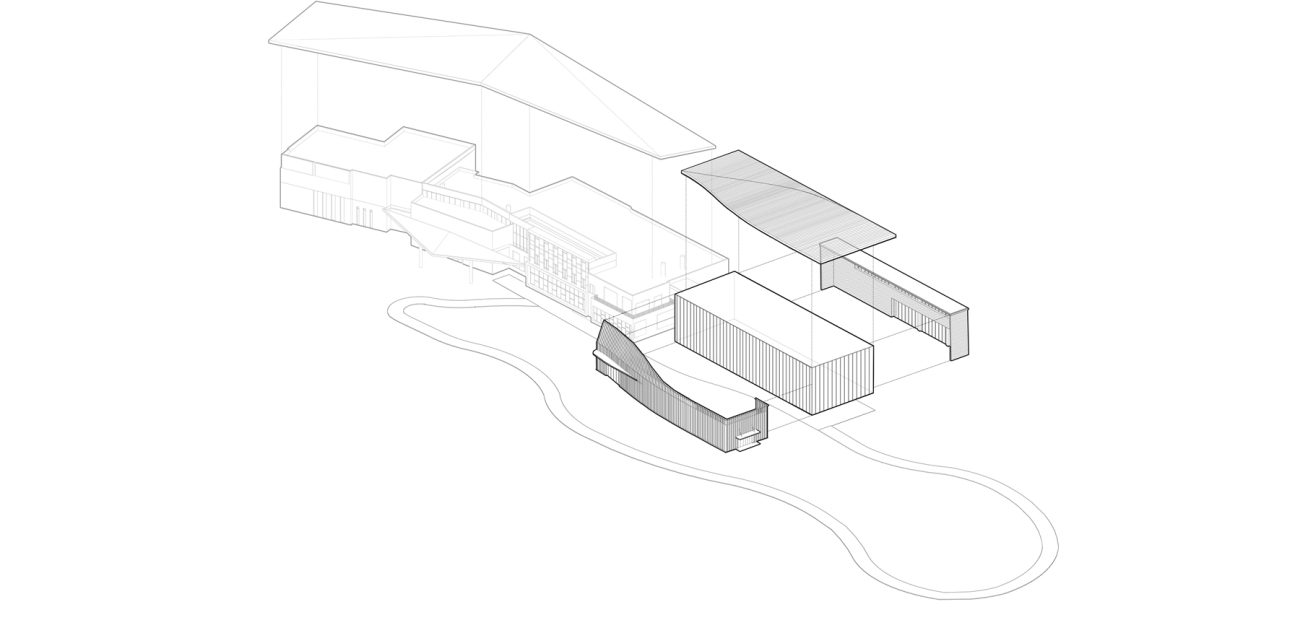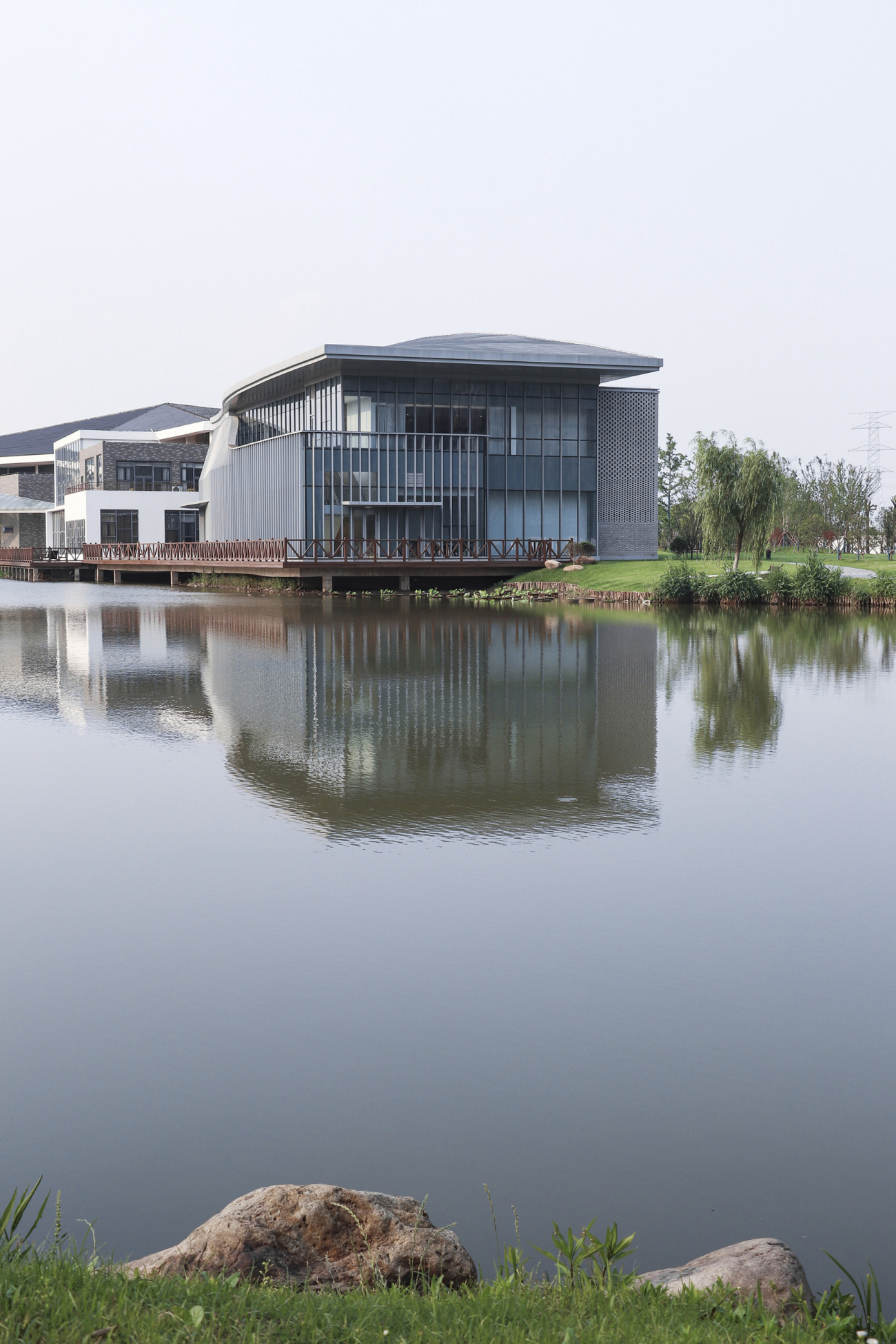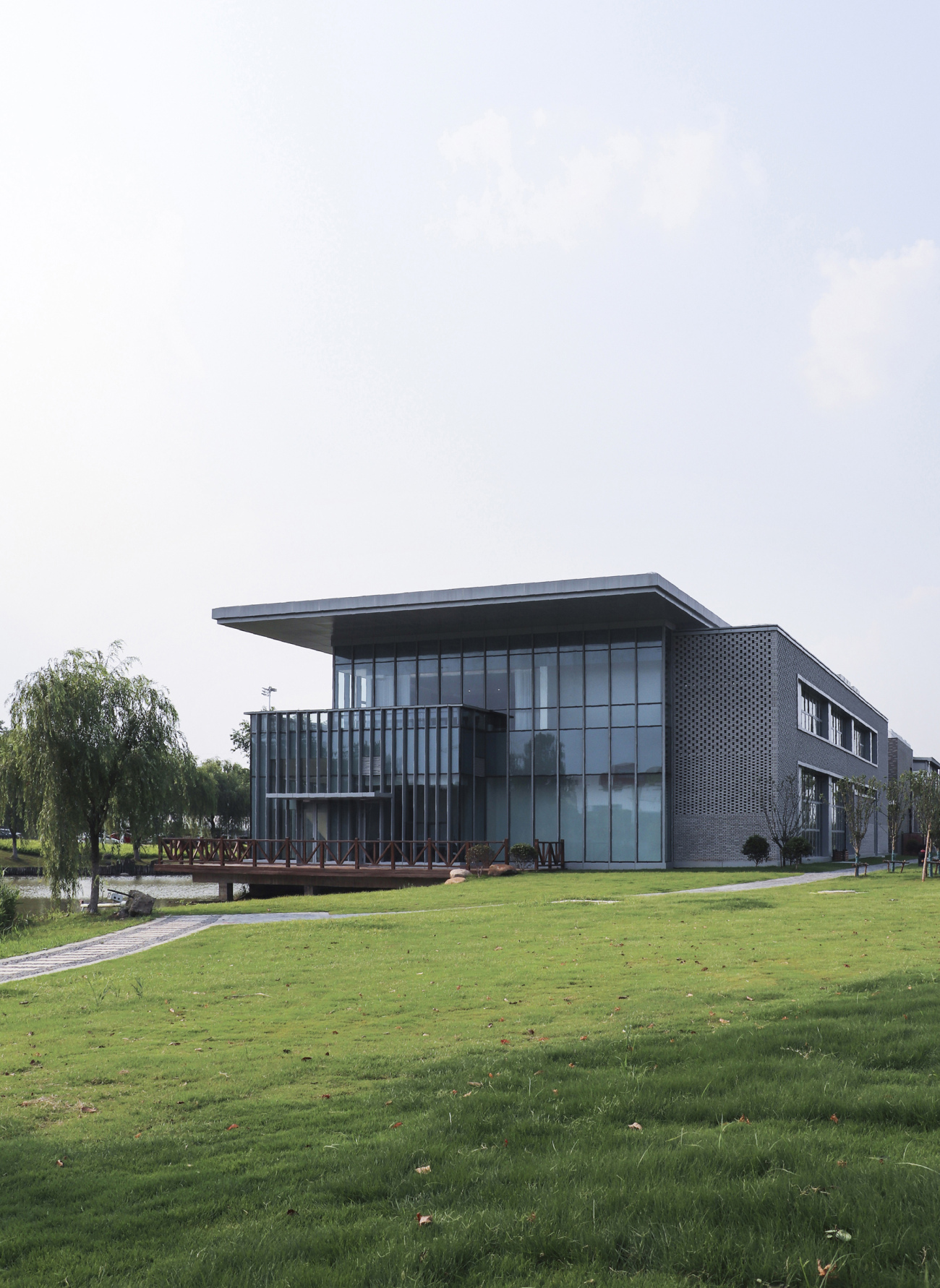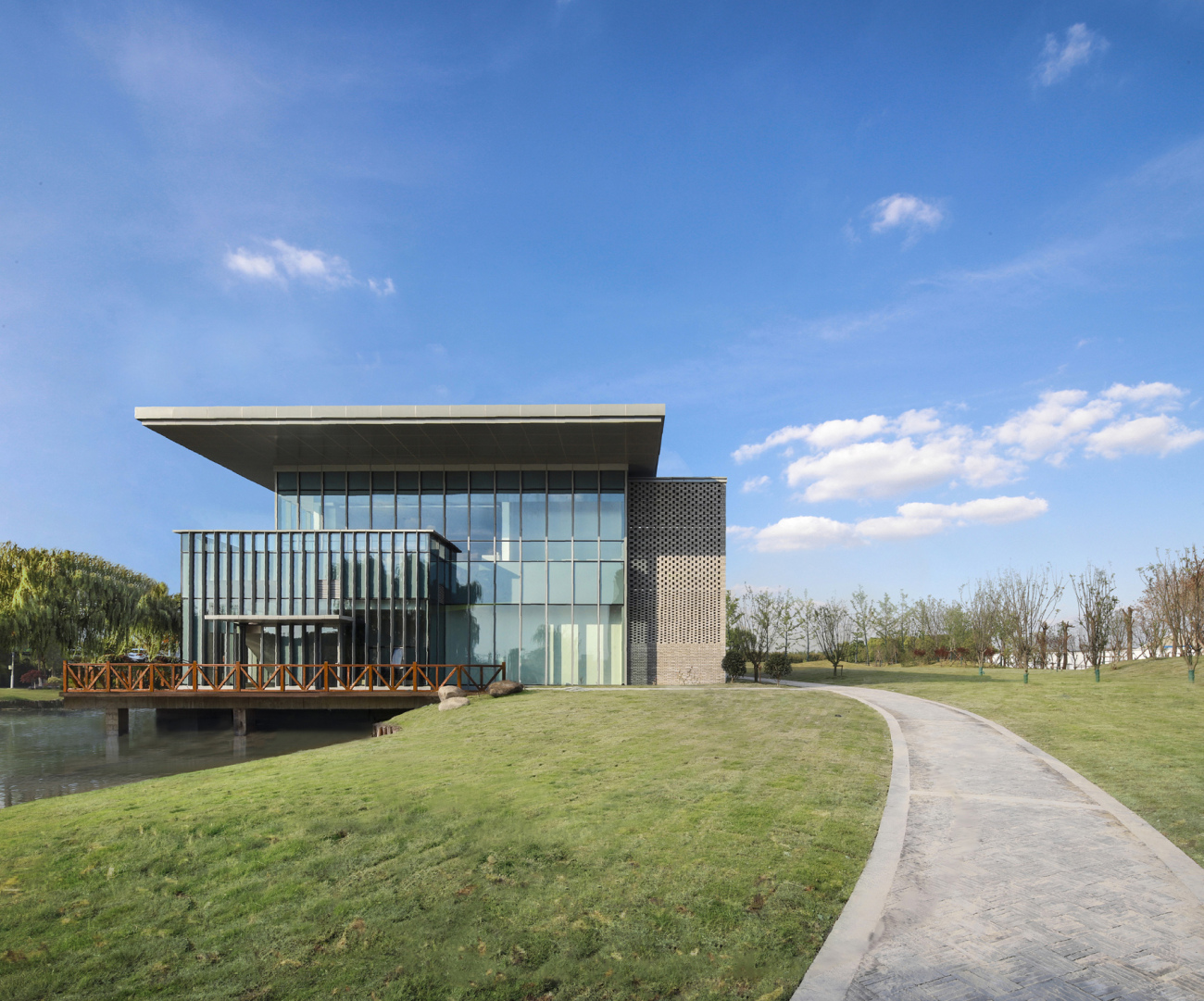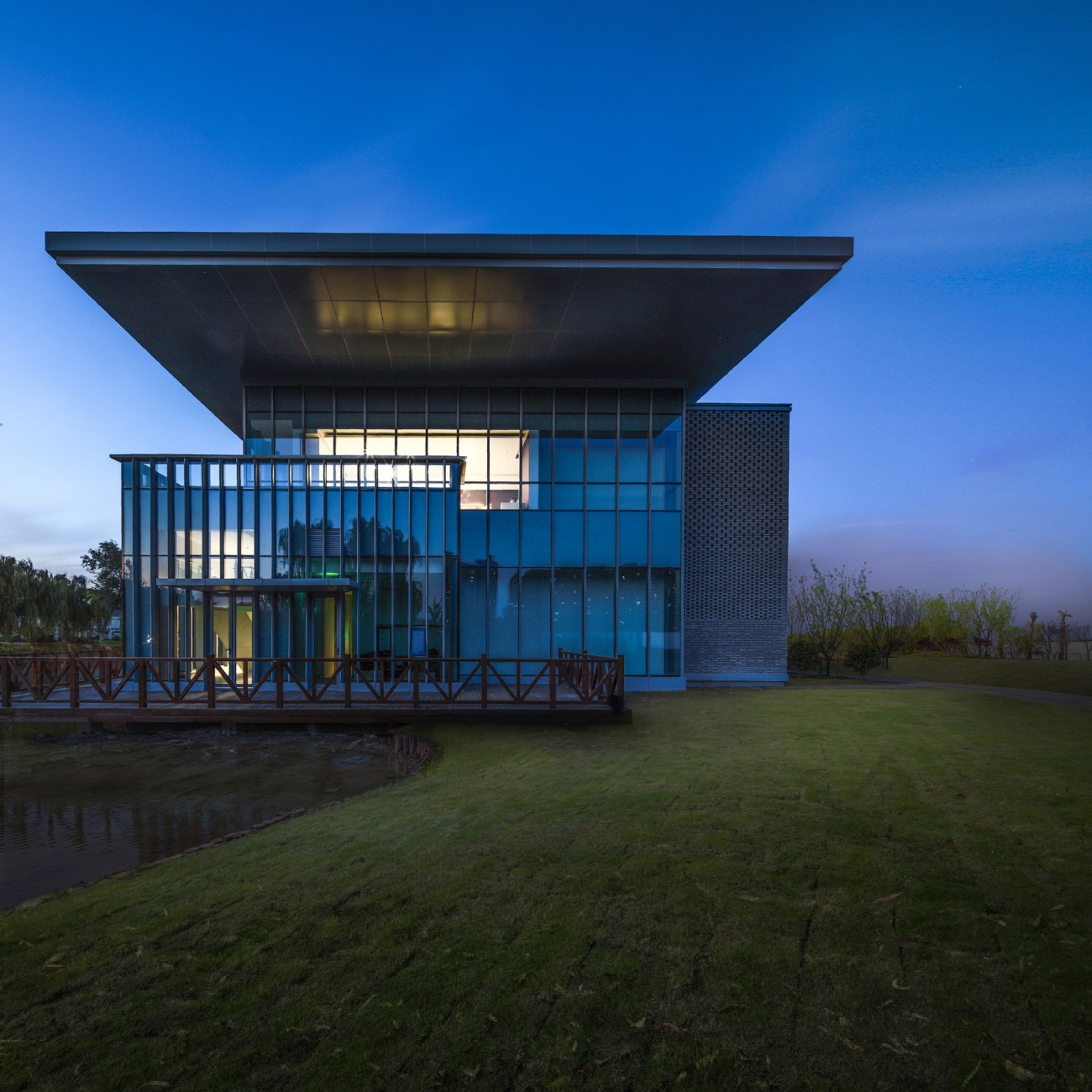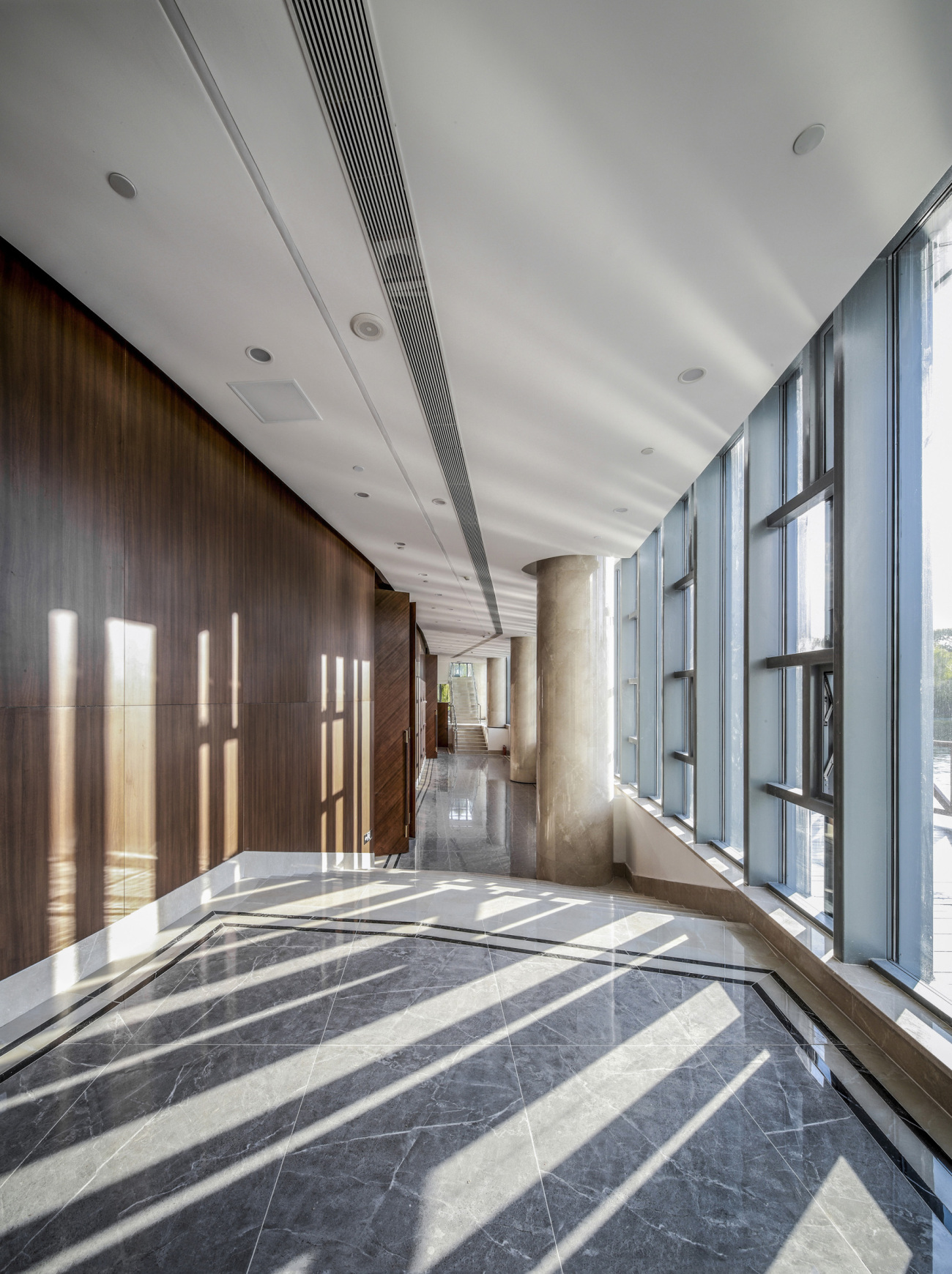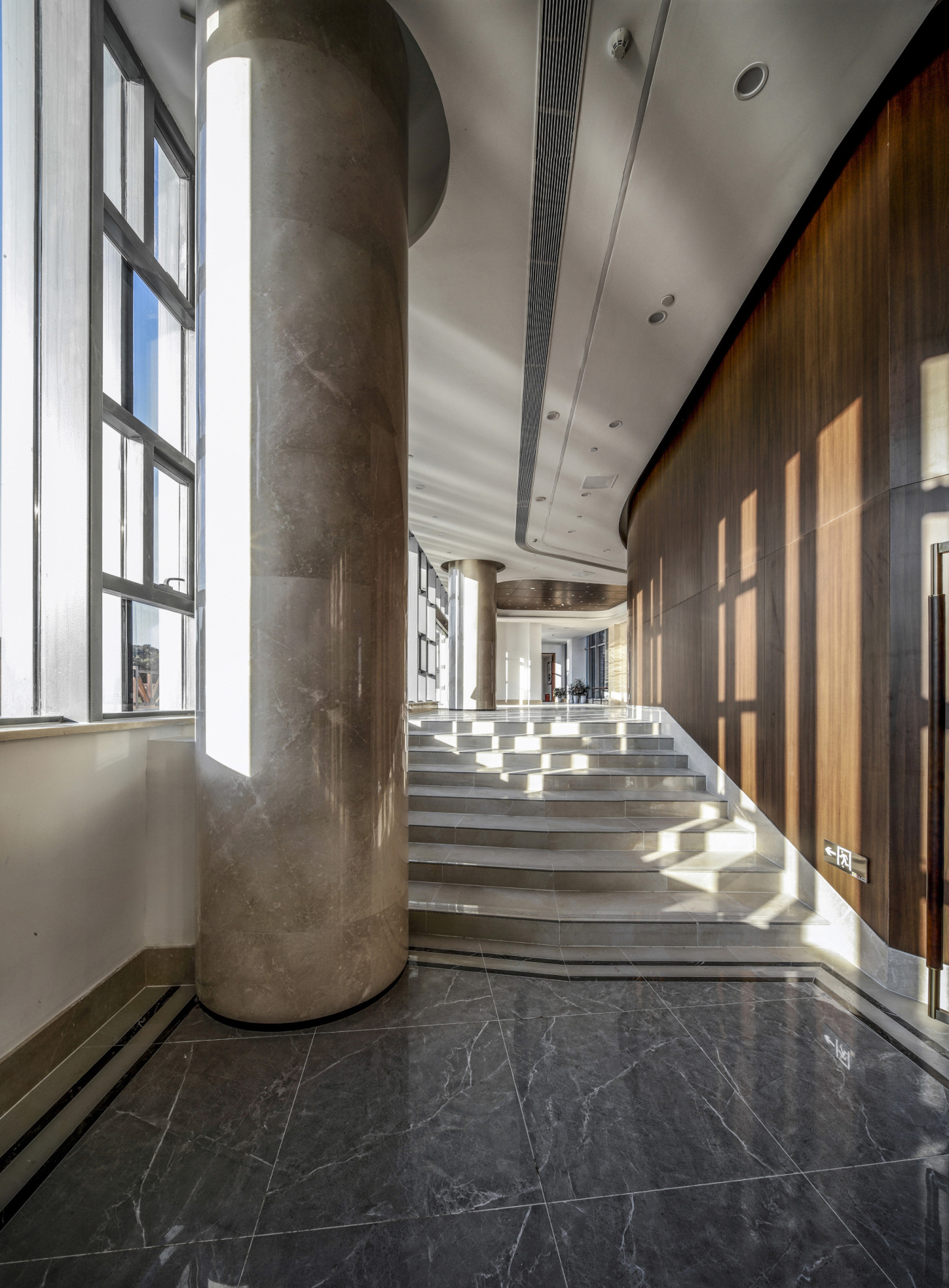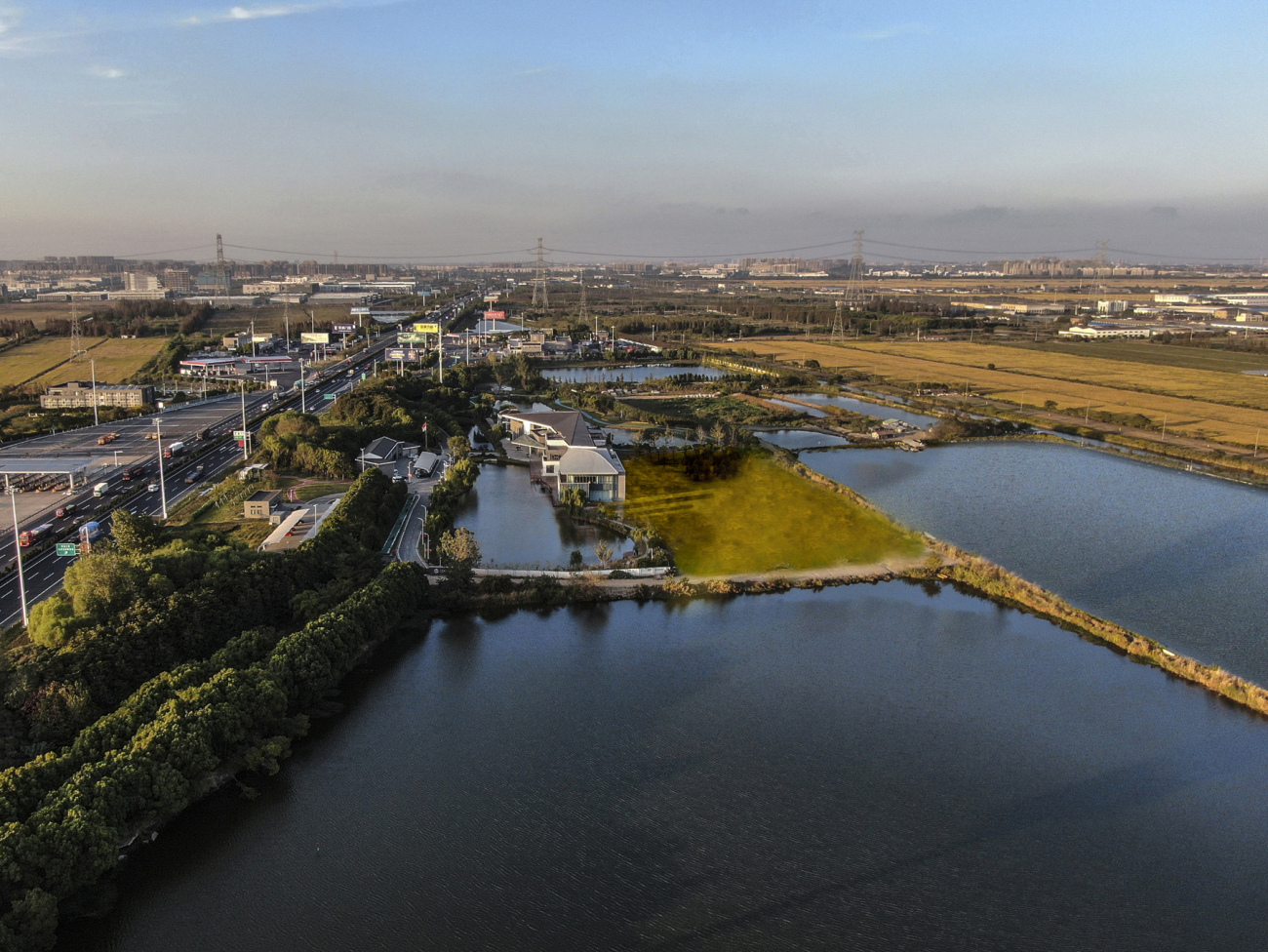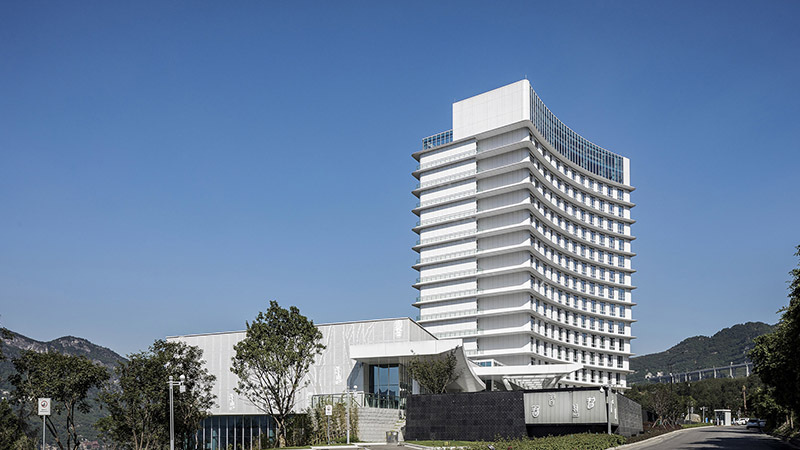这是一个小建筑,同时也是一个大建筑。说他小是因为他是苏通大桥指挥部的辅助用房,一共两层,其建筑面积仅有1500平米,并位于不起眼的高速公路边。当我们以车速120km每小时通过时,留给过路人能瞥见他的时间只有0.1秒。
This is a small building, but also a big building. It is small because it is the auxiliary building of the Sutong Bridge Command, with two floors and the gross built area of only 1,500 square meters, and is located on the inconspicuous side of the highway. When we pass by with a speed of 120km/h, the time left for passers-by to catch a glimpse of it is only 0.1 seconds.
说他大,一方面是因为他不仅需要将周边环境纳入考量,还受制于现状建筑的条件因素,我们更需要思考如何在老建筑旁边完成新建建筑的设计生成;另一方面,我们尝试在这样一个小建筑中能否用简单的语言来体现一定的复杂性与多样性。所以,他暗含了一个大大的意旨。
And it is a big building. On the one hand, because our design not only needs to take the surrounding environment into consideration, but also constrained by the conditions of the current building, we need to think about how to complete the design generation of the new building next to the old one; on the other hand, we try to see whether we can use a simple architectural language to reflect a certain complexity and diversity in such a small building. Therefore, it implies a great ambition.
新老建筑匍于水面
New and old building
场地鸟瞰
Aerial view
北侧紧邻的老建筑是一个非常不寻常的办公楼——超大的斜对角坡屋顶笼罩着整个建筑,加之立面元素杂乱。当我们将之解构,可以理解为一个漂浮的大屋顶加上混乱的立面所组成的建筑体。而一旁的新建筑作为其附属建筑,两者的整体性是我们首先需要考虑的问题。
The old building immediately to the north is a very unusual office building - the oversized diagonal sloping roof envelops the entire building, coupled with the clutter of facade elements. When deconstructed, it can be interpreted as a floating building with a large roof and a chaotic facade. As the new building is an auxiliary building, the unity of the two is the first thing we need to consider.
老建筑
Old building
保证整体性的第一步是对屋顶形式的解读——现状建筑以硕长的坡屋顶沿湖面布置倾覆于底部体块之上,新建筑也自然而然地将屋顶作为一个主要的形式语言来加以强调。我们采用了与之同向演进的屋面形式,并以柔化处理作斜向拼接,用双曲面的方式,让屋面体量向屋脊对角线方向聚拢。
The first step to ensure unity was the interpretation of the roof form - the existing building has a long sloping roof over the bottom blocks along the lake, and the roof is naturally emphasized as a major formal language in the new building. We used a similar roof form with a softening treatment for diagonal splicing and a hyperbolic approach to bring the roof volumes together diagonally towards the ridge.
同时屋面顺应老建筑方向,朝水面运动延伸,并微微打开,使之与老建筑达到既统一又富有变化的同频状态。当我们从或远或近各个角度望向建筑群,可以看到不同曲率蜿蜒蔓生的屋面带来不同的观看体验。
At the same time, the roof follows the direction of the old building, extends towards the water and opens up slightly, so that it achieves both unity and change with the old building. When looking at the complex from different angles, we can see the different curvatures of the meandering roofs bring different viewing experiences.
延续的屋面
Extended roofing
沿湖界面
Lakeside interface
湖面北望建筑
Looking north across the lake at the buildings
湖面南望建筑
Looking south across the lake at the buildings
西南角一瞥
Southwest side
曲形坡屋面
Curved slope roofing
屋顶朝湖面延伸打开
Roof extension open towards the lake
老建筑中的金属窗框、钢结构骨架和杂灰色砖墙等元素以近似拼贴的方式杂交出混乱的立面。如何保证新老建筑整体性的同时又能创造一个简洁现代的新建筑,这之间似乎存在了一些矛盾。我们选择的策略是运用拆分重整的手法以及多维复合的设计方法来进行建筑创作的实践。通过选取老建筑立面中最多用的几种材质,对老建筑立面进行解构,列举,归纳,然后形成新的建筑语言加以组合。这样既延续了老建筑的建筑表征,保留了与之对话的窗口,又使得新建筑得以突出其自身的空间特征。
Elements such as metal window frames, steel skeletons and gray brick walls from the old building are intermingled in an almost collage-like manner to create a chaotic facade. There seems to be a contradiction between how to ensure the unity of the old and new buildings and at the same time create a simple and modern new building. The strategy we chose is to utilize the method of disassembling and rearranging as well as the multi-dimensional composite design method to practice the architectural creation. By selecting the most frequently used materials in the old building facade, we deconstructed, enumerated and summarized the old building facade, and then formed a new architectural language to combine them. In this way, the architectural representations of the old building are continued, the window for dialog with them are preserved, and the new buildings are able to emphasize their own spatial characteristics.
老建筑立面分析
Old building elevation analysis
在临近水面的西侧我们试着用金属构件做竖向排列,来回应老建筑中大量出现的灰色金属材质,通过弯转以柔和的姿态随湖面方向运动,并逐渐打开,以此顺应池塘的豁朗开阔与水波荡漾。
On the west side near the lake, we tried to respond to the gray metal material that was abundant in the old building by arranging the metal components vertically, which moved with the direction of the lake through bending and turning in a gentle gesture and gradually opened up, so as to respond to the openness and ripples of the lake.
而弯转的立面构件与延伸的屋面挑板巧妙地嵌合出一道豁口,也一并构筑出半室外的狭长空间作为户外平台。从临水平台望去,可以看到细长的豁口沿水面扩散打开,随老建筑延伸的曲线则勾勒出了平静柔和的视觉印象,也使整个建筑形态从老建筑的直来直往渐渐过渡到新建筑的柔情似水。
The curved facade elements and the extended roof panels are skillfully embedded to create an opening, which also constructs a long and narrow semi-outdoor space as an outdoor terrace. Looking from the horizontal terrace, one can see the slender opening spreading out along the water surface, while the curves extending along with the old building outline a calm and soft visual impression, which also makes the whole building form gradually transition from the straight forwardness of the old building to the softness of the new one.
西南角鸟瞰
Aerial view of southwest corner
金属杆件随湖面方向运动
Metal rods change along the lake
豁口面向湖面打开
The building opens up towards the lake
嵌合下的户外平台
Outdoor terrace
而东侧,老建筑以大面的灰色花砖为基底面向农田。设计以此为契机,将老建筑混乱的花砖元素提取出来,以灰砖作为主要材质,并用类似的大小尺寸通过三种疏密的砌筑方式排布出
错落有致的立面构成,实现与老建筑的视觉呼应,形成新老建筑的统一与延续,而在新老建筑直接相邻的围合庭院处,这种对话得以自然彰显。
On the east side, the old building faces the farmland with large gray bricks. Taking this as an opportunity, the design extracts the chaotic brick elements of the old building, takes gray bricks as the main material, and arranges them in three sparse and dense masonry patterns with similar sizes to achieve a staggered facade composition with the old building.The staggered facade composition realizes the visual echo with the old building, forming the unity and continuity of the old and new buildings.This dialogue is naturally manifested in the enclosed courtyards where the old and new buildings are directly adjacent to each other.
新老灰砖延伸交接
New and old gray brick extensions
错落有致的立面构成
Staggered facade
新老建筑连接处
Connection of old and new building
三种疏密的灰砖排布
Three sparse and dense brick combinations
西侧灰砖界面
West interface
“凿户牖以为室,当其无,有室之用。”当我们回归最原始,也最朴实的造室手法,可以看到,以坡屋顶、金属杆件与砖墙组成的建筑包衣下,穿插虚置出一“无”的玻璃体量。有形但为无形造,玻璃体块作为内部功能空间,强调出了里与外,虚与实之间的界限与联系。
When we return to the most primitive and simple way of creating a room, we can see that under the architectural coat of sloping roofs, metal rods and brick walls, a glass volume is interspersed and placed in vain. Tangible but made for the invisible, the glass block as an internal functional space emphasizes the boundary and connection between inside and outside, between the virtual and the real.
金属杆件、灰砖以及玻璃体块这三个元素从老建筑中自由地蔓延,整合,交织,依存,进而互为表里,有机地组合在了一起,自此发展出了富有层次的造型元素与空间联系。
The three elements - metal rods, gray bricks and glass blocks - spread freely from the old building, integrate, intertwine and depend on each other, and then organically combine with each other to develop layered modeling elements and spatial connections.
轴侧图
Axial view
三种元素的交错围合
Interlocking enclosure of three elements
围合下的玻璃体量
Glass volume under enclosure
南立面
South elevation
夜景
Nightscape
围合的局部
Detail
交错的局部
Detail
在功能上,老建筑的报告厅略显局促,究其根本原因就在于只有4米不到的层高,如今置换到新建筑中扩大了面积,层高需要增加。但为了保持新老建筑的整体性,高度上必须一致,向上无法突破,只能向下拓展。于是我们下挖一米二的高度,将一层层高增至五米二,形成一个半地下空间。从门厅进入,狭长的线性通道被步梯与曲线打破,光线经由金属表皮的分解柔和地穿过玻璃自水面打入,纵深感在此被柔化。
Functionally, the old building's lecture hall was slightly cramped, the fundamental reason for this was that the floor height was less than 4 meters, and now that it has been replaced by a new building with an enlarged area, the floor height must be increased. However, in order to maintain the integrity of the old and new building, the height must be the same, upward can not break through, only downward expansion. So we dug down 1.2 meters to increase the height of the first floor to 5.2 meters, forming a semi-underground space. Entering from the foyer, the long and narrow corridor passage is broken by steps and curves, and the light is softly penetrated through the glass from the water surface through the decomposition of the metal skin, and the sense of depth is softened here.
线性通道
Corridor
半地下空间
Semi-underground space
我们尝试以此案为契机,在当下新建项目逐渐饱和而改造项目广泛兴起的背景下,针对如何更好地结合老建筑顺应场地,同时在当代语境下回应新的建筑历史观,提出一种设计方法,即通过对老建筑进行解构,拆分,单列,依据情境异动生长,进而合并为整体。
We try to use this case as an opportunity, in the context of the current saturation of new construction projects and the emergence of a wide range of renovation projects, to address the question of how to better integrate the old building with the site, and at the same time to respond to a new view of architectural history in the contemporary context, to propose a design methodology - that is, by deconstructing the old building, splitting it up, singling it out, and then merging it into a whole based on the context of the change.
通过多元素的摄取、糅合、梳理,既保留了与老建筑对话的窗口,保证整体性,又可以用新的手法将新建筑视为是老建筑生命的延续与深化,恰如其分地体现出建筑一定的复杂性与多样性。
By taking in, blending, and combing multiple elements, not only does it retain the window of connection with the old building to ensure unity, but it can also use a new approach to see the new building as a continuation and deepening of the life of the old building, which appropriately reflects a certain degree of complexity and diversity of the building.
湖面望向建筑
Looking across the lake to the building
场地鸟瞰
Aerial view
场地鸟瞰
Aerial view
项目名称(中文) 苏通大桥档案馆
项目名称(英文)
Sutong Bridge Archive
项目地址 江苏南通
设计单位 STWD十拓建筑
项目摄影 模糊建筑Studio
项目甲方 江苏苏通大桥有限责任公司
主创设计师 王纲
设计团队 王纲,曹明明,周鹏飞,王宁
建筑面积 1,200㎡
设计年份 2019
完成年份 2023
施工图设计 金螳螂AFD建筑设计有限公司
室内设计 苏州金螳螂建筑装饰股份有限公司(粱虓,王郭彬)
公司官网 http://www.i-stwd.com/
更新日期:2023-08-15 16:33:19
非常感谢 十拓建筑 带来的精彩项目, 查阅更多Appreciations towards STWD for sharing wonderful work on hhlloo. Click to see more works!
